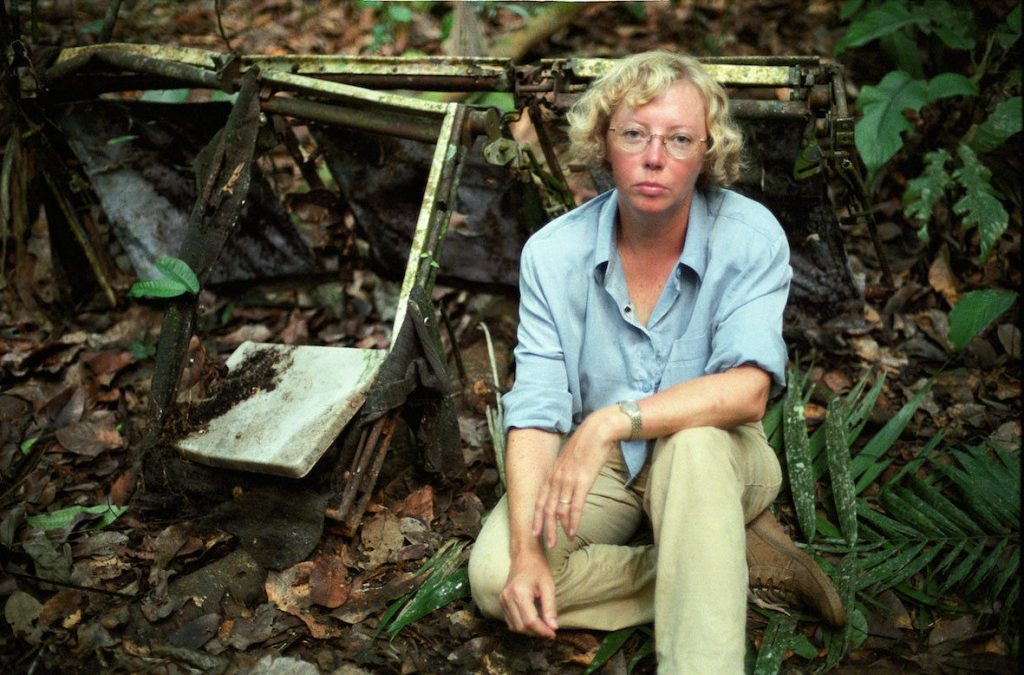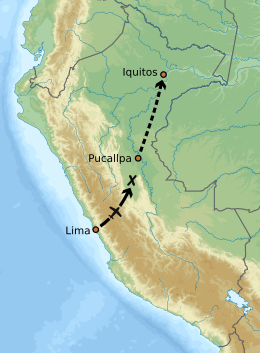Aerospace
She fell 10,000 ft to earth strapped to a seat and lived..!!

Juliane Diller (born 10 October 1954 in Lima as Juliane Margaret Koepcke) is a German biologist, born in Peru to German emigrants who is best known for being the sole survivor of 92 passengers and crew in the 24 December 1971, crash of LANSA Flight 508 (a LANSA Lockheed Electra OB-R-941 commercial airliner) in the Peruvian rain forest. After her airliner broke up in midair, she survived after falling about 3 km (10,000 feet) still strapped to her airliner seat, before the seat crashed through the rain forest canopy and came to rest on the forest floor.
Pakistan: Plane crashes with 40 passengers on board(Opens in a new browser tab)
Airplane crash: Juliane Koepcke was a German Peruvian high school senior student studying in Lima, intending to become a zoologist, like her parents. She and her mother, ornithologist Maria Koepcke, were traveling to meet with her father, biologist Hans-Wilhelm Koepcke, who was working in the city of Pucallpa.
Image: Juliane Koepcke revisited the crash site in 1998 for Werner Herzog’s documentary Wings of Hope

Image: Juliane Koepcke revisited the crash site in 1998 for Werner Herzog’s documentary Wings of Hope
The airplane was struck by lightning during a severe thunderstorm and broke up in mid-air, disintegrating at 3.2 km (10,000 ft). Koepcke, who was seventeen years old at the time, fell to earth still strapped into her seat. She survived the fall with only a broken collarbone, a gash to her right arm, and her right eye swollen shut. “I was definitely strapped in [the airplane seat] when I fell,” she remembered. “It must have turned and buffered the crash, otherwise I wouldn’t have survived.”
Her first priority was to find her mother, who had been seated next to her on the plane but her search was unsuccessful. With her eyeglasses lost and one eye swollen shut, she struggled to no avail. She later found out her mother had initially survived the crash as well, but died several days later due to her injuries.
Koepcke found some sweets which were to become her only food on her trip. After looking for her mother and other passengers, she was soon able to locate a small stream. She then waded through knee-high water downstream from her landing site, relying on the survival principle her father had taught her, that tracking downstream should eventually lead to civilization. The stream also provided clean water and a natural path through the dense rainforest vegetation.
During the trip, Koepcke couldn’t sleep at night due to numerous insect bites, which became infected. After nine days, several spent floating downstream, she found a boat moored near a shelter, where she found the boat’s motor and fuel tank. Relying again on her father’s advice, Koepcke poured gasoline on her wounds, which managed to extract thirty five maggots from one arm, then waited until rescuers arrived. She later recounted her necessary efforts that day: “I remember having seen my father when he cured a dog of worms in the jungle with gasoline. I got some gasoline and poured it on myself. I counted the worms when they started to slip out. There were 40 on my arm. I remained there but I wanted to leave. I didn’t want to take the boat because I didn’t want to steal it.”
Juliane Koepcke
“I had nightmares for a long time, for years, and of course the grief about my mother’s death and that of the other people came back again and again. The thought Why was I the only survivor? haunts me. It always will.”
After some time passed while she was in the hut, she heard voices nearby. As the voices neared, she saw three lumbermen come out of the forest. At first, the lumbermen were startled, thinking she was a water spirit. However, she described her ordeal and, having heard about a plane crash, the lumbermen believed her and fed her and cared for her wounds. After caring for her for a short time, the lumbermen took her on a seven hour boat ride to a lumber village.
Once she arrived at the village, a local pilot volunteered to fly her to a nearby hospital in Pucallpa run by missionaries. The flight took about fifteen minutes and a day after arriving at the hospital, Koepcke was reunited with her father. After being reunited with her father, Koepcke helped search parties locate the crash site and the victims of the crash. On January 12th, the search parties discovered Maria Koepcke’s body. Apparently, her mother had survived the fall as well, however she was prevented from moving as a result of her intense injuries. Maria Koepcke died several days after the crash and ensuing fall.

About Flight 508
LANSA Flight 508 was a Lockheed L-188A Electra turboprop, registered OB-R-941, operated as a scheduled domestic passenger flight by Lineas Aéreas Nacionales Sociedad Anonima (LANSA), that crashed in a thunderstorm en route from Lima, Peru toPucallpa, Peru, on December 24, 1971, killing 91 people – all 6 of its crew and 85 of its 86 passengers.
The aircraft was flying at about 21,000 ft / 6,400 m above Mean Sea Level when it encountered an area of thunderstorms and severe turbulence. There was evidence the crew decided to continue the flight despite the hazardous weather ahead, apparently due to pressures related to meeting the holiday schedule.
Accident investigation report :
“About forty minutes after take-off, the aircraft entered a zone of strong turbulence and lightning. After flying for twenty minutes in this weather at FL210 lightning struck the aircraft, causing fire on the right wing which separated, along with part of the left wing. The aircraft crashed in flames into mountainous terrain.”
Her experience was widely reported and is the subject of two feature length documentary films. The first was I miracoli accadono ancora (1974) by Italian filmmaker Giuseppe Maria Scotese; it was released in English as Miracles Still Happen (1975) and is sometimes called The Story of Juliane Koepcke. Twenty-five years later, director Werner Herzog revisited the story in his film Wings of Hope (2000). Herzog was inspired to make the film as he narrowly avoided taking the very same flight while he was location scouting for Aguirre, Wrath of God. His reservation was canceled due to a last minute change in itinerary.
liked it ..! ?
Share with your friends and families

Aerospace
Indigo will soon launch Air Taxi Service in India

InterGlobe Enterprises, the parent brand of IndiGo, is set to revolutionize travel in India with its upcoming air taxi service.
Scheduled for a potential launch in 2026, this innovative venture promises a seamless journey for passengers between two bustling hubs. Delhi and Gurgaon in Haryana. The forthcoming service is projected to revolutionize the daily commute, offering passengers a swift aerial journey covering the distance in a mere 7 minutes.
This remarkable efficiency contrasts starkly with the conventional 90-minute drive, underscoring the immense time-saving potential for commuters. The anticipated fare, ranging from Rs 2,000-3,000, makes this innovative mode of transport not only swift but also remarkably competitive in pricing.
At the heart of this ambitious endeavor lies a strategic partnership with Archer Aviation, a pioneer in electric vertical takeoff and landing (eVTOL) aircraft technology. Under this collaboration, Archer will supply 200 state-of-the-art eVTOL aircraft, representing an investment of US$ 1 billion. These cutting-edge aircraft, capable of accommodating up to four passengers alongside the pilot, epitomize the future of sustainable air travel.
Powered by six battery packs, Archer’s eVTOL aircraft boast rapid charging capabilities, enabling a swift turnaround between flights. With a charging time of just 30-40 minutes, these eco-friendly aircraft ensure minimal downtime, maximizing operational efficiency.
Similar services are anticipated to be introduced by the joint venture in Bengaluru and Mumbai as well. Nevertheless, the service rollout period has not yet been made public by the company. Next year, it is anticipated to get its certification. Following this, the company will start the certification procedure with the Directorate General of Civil Aviation (DGCA).
Aerospace
Which is bigger 777x or 787 aircraft ?

The 777X is a new series of the Boeing 777 family and is designed to be larger and more efficient than its predecessor. It features two variants: the 777-8 and the 777-9, being the larger of the two.
The Boeing 777X emerges as the larger sibling within the Boeing family, representing a significant leap forward in both size and efficiency. Comprising two variants, the 777-8 and the 777-9, the latter takes the crown as the larger of the two. With its expansive fuselage and impressive wingspan, the 777X is tailored for long-range journeys and boasts a substantial passenger capacity.
On the other hand, the Boeing 787, affectionately known as the Dreamliner, occupies a niche in the market as a smaller yet formidable aircraft designed for medium to long-range flights. Its distinguishing feature lies in its composite fuselage, a technological marvel that renders it lighter and more fuel-efficient compared to conventional aluminum counterparts. The Boeing 777X is larger than the Boeing 787 aircraft.
When it comes to passenger capacity, the 777-9 reigns supreme, typically accommodating a sizeable contingent of 400-425 passengers in its standard configuration. In contrast, the 787, with its more modest dimensions, typically carries between 240-290 passengers, depending on the variant and layout.
One of the remarkable innovations introduced with the 777X is its folding wingtips, a feature designed to address the logistical challenges of accommodating such a large aircraft in conventional airport gates. These folding wingtips enable the 777X to retract its wings, allowing it to fit into gates designed for smaller aircraft while still reaping the benefits of an extended wingspan during flight, thereby enhancing fuel efficiency and operational flexibility
Aerospace
China Secures Production Certificate for Mass Production of Pilotless eVTOL Aircraft

The first passenger-carrying pilotless electric vertical takeoff and landing (eVTOL) aircraft in the world, the EH216-S, has received the Production Certificate for its eVTOL aircraft from the Civil Aviation Administration of China (CAAC).
This is a significant milestone for EHang Holdings Limited, the leading UAM technology platform company in the world. This outstanding accomplishment is another big step towards mass manufacturing for the eVTOL aircraft and the ensuing commercial operations, building on the ground-breaking acquisition of the Type Certificate and the Standard Airworthiness Certificate for the EH216-S.
The PC is a crucial certificate that the aircraft maker receives from the CAAC, the country’s aviation authority. By obtaining this certificate, EHang has demonstrated that it has set up a quality management system for mass production that satisfies the airworthiness regulation standards set forth by the CAAC, and the company has been given permission to continue producing mass quantities.
It is also a strong guarantee of the calibre of the goods made by EHang. Raw materials, supplier management, manufacturing organisation, production quality control, aircraft pre-delivery test, after-sales repair and maintenance, etc. are all included in the mass production quality management system for the EH216-S.
To ensure that every aircraft and its components that roll off the production line strictly adhere to the approved type design and safety requirements, the system sets clear guidelines and documentation for every step in the production procedure. This ensures comprehensive traceability and safety control.





















